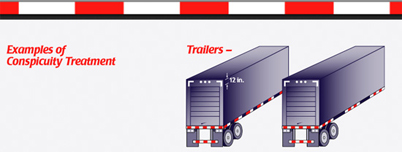Truck Night Visibility Rear Side Crash
Car v. Truck Tractor Trailer Accidents
Visibility at night is a major factor especially in rear and side accidents where the car hits the truck or trailer.
Semi trucks and big rig trailers are required to have reflective tape to help a car driver see the outline of the whole big rig. In 2001, the NHTSA (National Highway Transportation Safety Administration) conducted a study and found an astounding effectiveness of the simple corrective measure of adding reflective tape to these big rigs.
It reduced side and rear impacts into trailers, in dark conditions (including "darknot- lighted," "dark-lighted," "dawn," and "dusk") by 29 percent. In "dark-not-lighted" conditions, the tape reduced side and rear impact crashes by 41 percent. Tape is especially effective in reducing injury crashes. In dark conditions, it reduced side and rear impacts that resulted in fatalities or injuries to drivers of any vehicle by 44 percent. 17. [1]
Essentially, just by adding reflective tape to the outline of a semi truck and trailer can significantly reduce injury accident as well as fatalities. This is because one type of accident that occurs when a car driver can not see the outline of the big rig is what is called a truck underride accident, and these can be especially aweful to the occupants of the automobile, and they can occur in both side and rear impact accidents with the big rig.
The purpose of retroreflective tape is to increase the visibility of heavy trailers to other motorists, especially in the dark. At those times, the tape brightly reflects other motorists' headlights and warns them that they are closing on a heavy trailer. In the dark, without the tape, many trailers do not become visible to other road users until they are dangerously close. The alternating red-andwhite pattern flags its bearer as a heavy trailer and at the same time helps other road users gauge their distance and rate of approach. [1]

Studies have also revealed that even mud on the reflective tape or dirty reflective tape can cause a loss of visibility to car drivers. Thus, this can be an important facet of post accident investigation. The reflective tape can also wear out or become damaged on older rigs.
All heavy trailers manufactured on or after December 1, 1993 must be equipped with red-andwhite retroreflective tape, sheeting and/or reflex reflectors around the sides and rear to make them more conspicuous. The National Highway Traffic Safety Administration (NHTSA) established this requirement, with its various options, in December 1992 by amending Federal Motor Vehicle Safety Standard (FMVSS) No. 108, "Lamps, Reflective Devices, and Associated Equipment." However, retroreflective tape has been used almost exclusively for meeting the standard, and it is the subject of this evaluation. [1]
Such a simple improvement can save so many lives and prevent so many accidents. The NHTSA proposes the difference when all heavy trailers have conspicuity tape, the tape will be saving an estimated 191 to 350 lives per year, preventing approximately 3,100 to 5,000 injuries per year, and preventing approximately 7,800 crashes per year, relative to a hypothetical fleet in which none of the trailers have the tape.
In dark conditions the tape reduces side and rear impacts into heavy trailers by 29 percent.
A truck accident attorney will investigate the condition of the reflective tape on the big rig, among other factors in an accident. It is an example of one of the accident investigation factors and why it is so important to contact an attorney as soon as you are able to after an accident. If the truck has been repaired after the accident, there is a good chance that dirty tape may get cleaned, or that worn out or missing tape will be replaced before the rig goes back onto the road, and critical evidence will be lost.
Learn More
1. The Effectiveness of Retroreflective Tape on Heavy Trailers